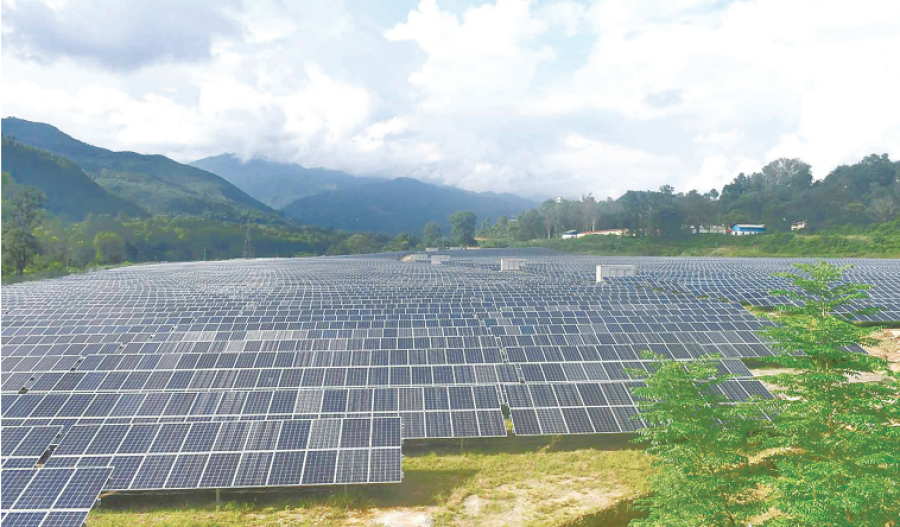Money
Call for favourable policy to raise share of solar power in energy mix
Only 44MW solar energy, which is less than two percent of total power production in the country, is connected to the national grid.
Prithvi Man Shrestha
Nepal participated in the assembly of the International Solar Alliance (ISA) for the first time last week with the country aiming to increase the share of solar power in its energy mix.
The ISA, with 110 member and signatory countries, works with governments to improve energy access and security worldwide and promote solar power as a sustainable way to transition to a carbon-neutral future.
Nepal’s Parliament is yet to ratify the ISA framework. The country participated in the meeting as an observer despite being a signatory to the framework.
The ISA aims to unlock $1 trillion of investments in solar power by 2030 while reducing the cost of the technology and its financing.
Nepal aims to increase the share of solar, wind, biomass and other alternative energies to 10 percent in the energy mix by 2030.
According to the Ministry of Energy, Water Resources and Irrigation, as much as 44 megawatts of solar energy has been connected to the national grid as of last fiscal year ended mid-July which accounted for just 1.94 percent of the total installed capacity of power stations in the country.
Nepal’s total power generation in mid-July stood at 2268MW, according to the energy ministry.
According to the Department of Electricity Development, it has granted a survey licence for 43 projects with a combined capacity of 1,238.7MW. Major projects getting survey licences include the 300MW Jhapa SPV Power Plant and 200MW Nepalgunj SPV Power Plant to be developed by GT Energy; 250MW Grid Connected Solar Project in Kohalpur; and Banganga to be developed by Risen Clean Energy Nepal.
On top of that, the department has granted construction licences for 21 solar energy projects with a combined capacity of 133.56MW.
Ram Prasad Dhital, former board member of the Electricity Regulatory Commission, said that the country needs to diversify its energy mix to ensure energy security considering that Nepal is prone to earthquakes and landslides, which could affect hydropower projects.
The private sector has, meanwhile, questioned the government’s commitment to promoting solar power. In March, the Nepal Electricity Authority decided to reduce the maximum purchase price for electricity generated by solar plants as the state-owned utility prepares to procure solar energy through competitive bidding.
The authority decided to pay a maximum of Rs5.94 per unit for solar power. For the last three years, the authority had been paying Rs7.30 per unit as provisioned by the Working Procedures on Grid-Connected Alternative Electric Energy.
Considering the falling prices of solar energy across the world, the NEA said it decided to slash the prices it is ready to pay for solar energy.
However, solar power producers say prices of solar panels and equipment have risen globally amid supply constraints and the Russian invasion of Ukraine.
“Investors may need to wait for 15 to 20 years to recover their investment,” said Bharat Kumar Malla, senior vice-president of the Solar Electric Manufacturers Association Nepal, raising questions whether the government wanted to promote solar energy. “The investors will rethink whether to invest in solar plants in Nepal.”
In November 2020, solar energy prices in India hit a record low of INR2 per unit under competitive bidding. But lately, there has been a rise in the cost of solar plant installation.
According to a March report by the CNBC, the US-based news channel, prices jumped in 2021 as broad economic challenges—including supply chain constraints—hit the industry, though declining costs have been a key driving force behind solar adoption.
In some segments of the solar industry, prices rose as much as 18 percent last year, according to the report citing data from the Solar Energy Industries Association and Wood Mackenzie.
According to a report in PV Magazine in July, prices of modules have increased by more than 40 percent to $0.27 to $0.28 per watt over the last 18 months.
As a result, the bid tariffs have increased from the lows of INR 1.99 per unit kWh in December 2020 to INR 2.2 per unit to 2.5 per unit in July.
Malla said that growing input costs are making solar plants unfeasible as the NEA has decided to reduce the prices it is ready to pay the developers.
Those who have already invested in acquiring lands with the hope of recovering investment within 10 years would have to revise their plan.
According to Dhital, the government needs to provide for a predictable environment to attract investment in the solar sector. “The NEA could offer existing prices for those who have already made investments for solar plants while offering lower prices to those who have yet to invest,” he said.
Officials, however, said that despite heavy reliance on hydropower, the government has continued to prioritise solar electricity too to ensure energy security. “Falling prices of solar energy over the past decade have also made it an alternative energy source needed for the country’s energy mix,” said Madhu Bhetuwal, spokesperson for the energy ministry. “There has been a downfall in solar energy prices by 80-85 percent in the last 10 years.”
And, there has been an effort to reduce the cost further to make this energy affordable to all. One of the aims of the ISA is to reduce its cost, whose fifth assembly was held in New Delhi from October 17–20. “We joined the ISA as it offers us a platform to share best practices and technologies on solar from which Nepal can benefit,” said Bhetuwal.



 16.12°C Kathmandu
16.12°C Kathmandu















